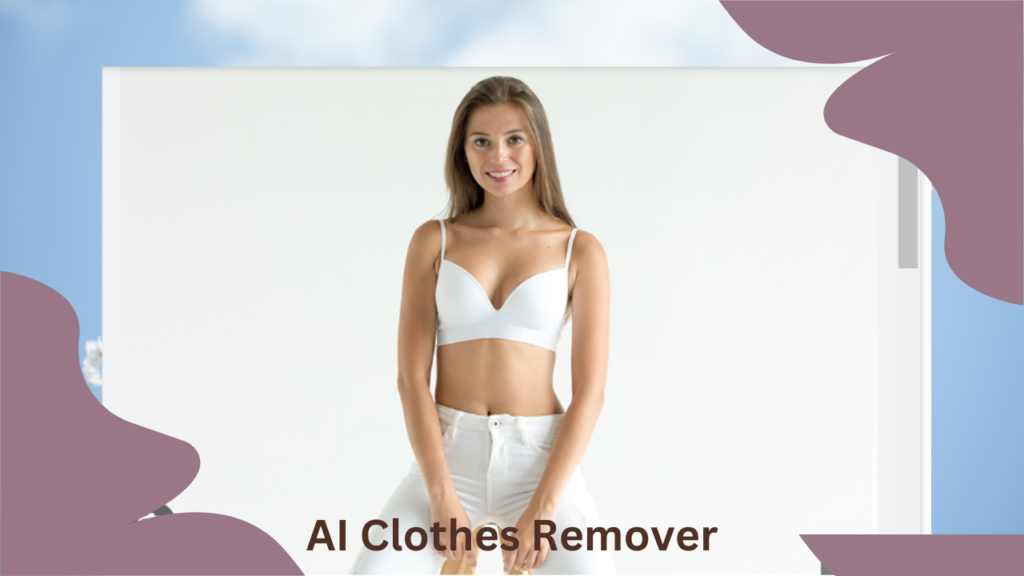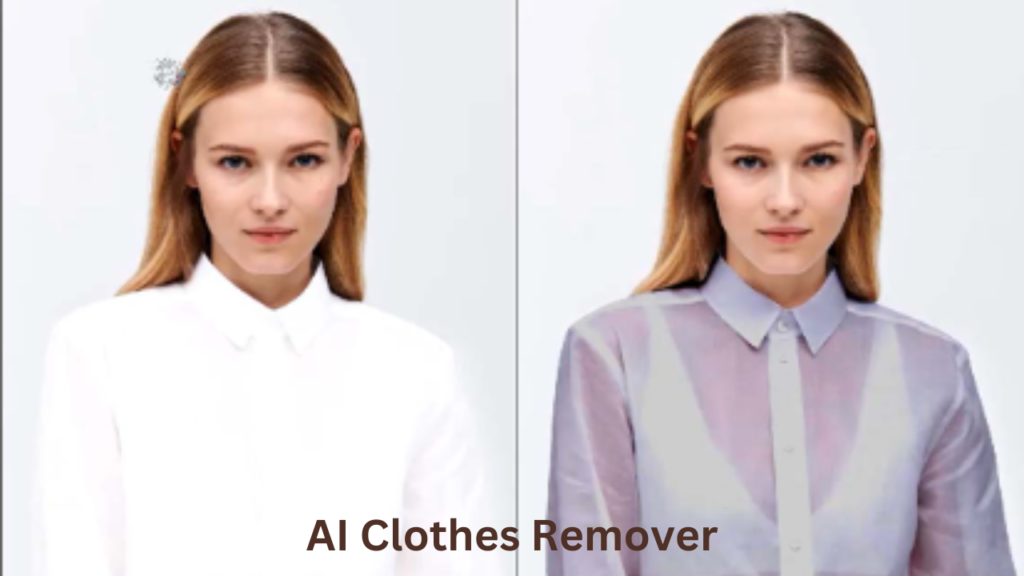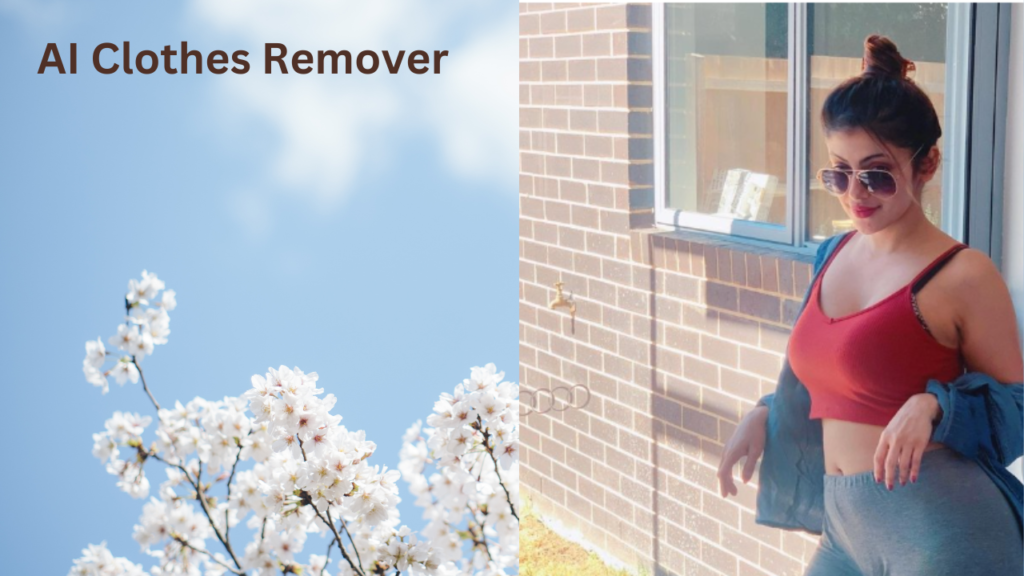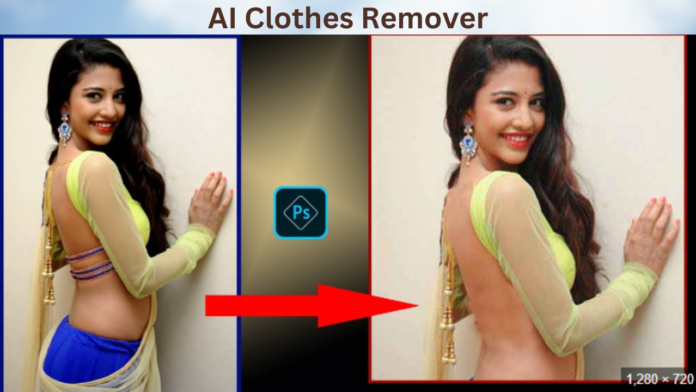At Stylesparkle.in, developing an AI clothes remover involves leveraging advanced machine learning techniques to enhance fashion experiences. Our process begins with gathering a diverse dataset of clothing images, which is then meticulously annotated to train our AI model. Utilizing cutting-edge technologies like U-Net and Mask R-CNN, we build a robust model capable of accurately identifying and removing clothing from images.

Our development involves integrating this model into a user-friendly application, allowing seamless image uploads and instant processing. The backend, powered by TensorFlow or PyTorch, ensures rapid and accurate image manipulation. Stylesparkle.in prioritizes user privacy and data security, adhering to best practices to protect personal information.
Through continuous testing and optimization, Stylesparkle.in delivers a reliable and efficient AI clothes remover that revolutionizes how fashion content is created and interacted with.
AI clothes recovery, or AI-driven clothing recovery, refers to the use of artificial intelligence technologies to enhance the processes involved in collecting, sorting, recycling, and reusing clothes. Here’s a breakdown of what it entails:
1. Clothing Sorting
AI systems can automate and improve the sorting of clothes based on various criteria such as fabric type, color, brand, or condition. This is achieved using technologies like computer vision and machine learning. AI algorithms analyze images of clothing items to categorize and sort them more efficiently than traditional methods.
2. Waste Reduction
By using AI to identify and sort clothes that are suitable for reuse or recycling, the amount of clothing waste that ends up in landfills is reduced. AI can help separate items that are still in good condition from those that are damaged or beyond repair.
3. Recycling and Upcycling
AI can assist in determining the best recycling or upcycling methods for different types of fabrics and materials. For example, it can help in identifying which items can be transformed into new products or which materials can be broken down and repurposed.
4. Supply Chain Optimization
AI technologies can optimize the supply chain by predicting trends and managing inventory more effectively. This reduces the production of excess clothing, which in turn reduces waste.
5. Consumer Engagement
AI-driven platforms can engage consumers by recommending clothing recycling options or providing incentives for recycling. They can also educate users on the environmental impact of their clothing disposal choices.
Examples of AI in Clothing Recovery
- Automated Sorting Systems: Companies are developing AI systems that use cameras and sensors to sort donated clothing into various categories for further processing.
- Predictive Analytics: AI models predict future fashion trends and consumer behavior, which helps brands produce less waste by aligning their production with actual demand.
Benefits
- Efficiency: AI can process and sort large volumes of clothing quickly and accurately.
- Sustainability: Reduces the environmental impact of clothing waste by promoting recycling and reuse.
- Cost-Effective: Can reduce labor costs and improve operational efficiency in clothing recovery processes.
Challenges
- Technical Limitations: Developing AI systems that accurately sort diverse clothing items can be complex.
- Ethical Concerns: Issues related to data privacy and the potential for job displacement due to automation.
AI-driven clothing recovery represents a significant advancement in the efforts to address clothing waste and improve sustainability in the fashion industry.
how to use AI Clothes Remover
AI clothes removers, sometimes known as AI-powered clothing removal tools, are used primarily for tasks related to image processing and editing. They leverage artificial intelligence to remove or alter clothing in digital images. These tools are typically used in contexts such as:
- Virtual Fitting Rooms: To show how clothes will look on a person before they try them on.
- Digital Fashion Design: For designers to visualize how different fabrics and designs will look on a model.
- Content Moderation: To automatically identify and blur or remove inappropriate clothing from images.
Here’s a step-by-step guide on how to use an AI clothes remover:
1. Choose the Right Tool
Select an AI clothes remover tool that suits your needs. Some popular options include:
- Online AI Platforms: Websites like DeepArt.io or Remove.bg that offer various AI image editing services.
- Specialized Software: Tools like Adobe Photoshop with AI plugins or dedicated apps for virtual fitting.
2. Upload the Image
- Prepare the Image: Ensure the image you want to process is of high quality for better results.
- Upload: Follow the tool’s instructions to upload the image. Most platforms allow you to drag and drop the file or use a file upload button.
3. Configure Settings (if applicable)
- Select Options: Some tools might offer settings to specify how you want the clothing to be removed or altered.
- Adjust Parameters: Fine-tune parameters such as sensitivity, blur level, or replacement options.

4. Run the AI Process
- Start Processing: Initiate the AI processing by clicking a button like “Start,” “Remove,” or “Process.” The AI will analyze the image and make the necessary adjustments.
5. Review and Edit
- Check Results: Review the output to ensure it meets your requirements. The AI might not always be perfect, so manual adjustments might be needed.
- Edit: Use any available editing tools to refine the image if needed.
6. Save or Export
- Download the Image: Save the processed image to your device. Most tools provide options to download the edited image in various formats.
7. Compliance and Ethical Considerations
- Respect Privacy: Ensure you have the right to use and edit the images, especially if they involve personal data or identifiable individuals.
- Use Responsibly: Be mindful of how the edited images are used, ensuring they comply with ethical and legal standards.
Examples of Use Cases:
- Fashion E-commerce: Virtual try-ons where users can see how different clothes will look on them without physically trying them on.
- Digital Content Creation: Removing or altering clothing in images for creative or professional purposes.
- Education and Training: Demonstrating how AI can be used in image processing and machine learning applications.
Each tool or platform may have its own specific instructions, so it’s always a good idea to refer to the user guide or help documentation provided by the service you are using.
what is the commericial use AI Clothes Remover?
Commercial Uses of AI Clothes Remover
AI clothes removers are transformative tools with a wide range of commercial applications across various industries. Here’s a detailed look at their potential uses:
1. Virtual Fitting Rooms
AI clothes removers are instrumental in virtual fitting rooms for e-commerce. By removing clothing from images, these tools allow consumers to visualize how different garments will look on them or on models. This enhances the online shopping experience, reducing the need for physical try-ons and decreasing return rates due to size or style mismatches.
2. Fashion Design and Prototyping
In the fashion industry, designers use AI clothes removers to streamline the design process. By removing existing clothing from images, designers can experiment with new patterns, colors, and fabrics on virtual models. This helps in creating prototypes more efficiently and visualizing final products before physical production, saving both time and resources.
3. Content Creation and Marketing
For content creators and marketers, AI clothes removers facilitate the creation of engaging and tailored marketing materials. They can be used to alter images for ads, remove distractions, or focus on specific clothing items. This ensures that marketing content aligns with brand aesthetics and targets the desired audience effectively.
4. Digital Clothing Archives
Retailers and fashion houses maintain digital archives of clothing designs and collections. AI clothes removers assist in creating clean, focused images of garments for these archives. This not only improves inventory management but also provides a polished visual record for future reference or marketing purposes.

5. Content Moderation
In digital platforms and social media, AI clothes removers can assist in content moderation by automatically detecting and blurring or removing inappropriate clothing from images. This ensures that platforms adhere to community guidelines and maintain a respectful environment.
6. Personalized Shopping Experiences
AI clothes removers contribute to personalized shopping experiences by allowing consumers to visualize how custom or personalized clothing will look on them. This technology helps in making tailored recommendations and enhances customer satisfaction by offering a more interactive and customized shopping journey.
7. Retail Analytics
Retailers can use AI clothes removers to analyze trends and customer preferences by processing large volumes of product images. By identifying and removing clothing elements, they can focus on the overall design trends and consumer behavior, leading to better inventory management and targeted marketing strategies.
8. Augmented Reality (AR) Integration
AI clothes removers can be integrated into augmented reality applications, allowing users to see how clothing items would look in real-world settings. This integration enhances the shopping experience by providing a more immersive and interactive way to try on clothes virtually.
In summary, AI clothes removers offer numerous commercial benefits by improving virtual fitting experiences, enhancing fashion design processes, and optimizing content creation and marketing. Their applications span various sectors, from retail and fashion to digital content moderation and personalized shopping, making them a valuable asset in modern commerce.
why have to need AI Clothes Remover?
AI clothes removers are increasingly necessary in various sectors due to their ability to address specific challenges and enhance user experiences. Here’s why they are valuable:
1. Enhanced Virtual Fitting Experiences
AI clothes removers allow for more realistic and accurate virtual try-ons. By removing existing clothing from images, these tools help customers visualize how new garments will look on them or on models. This improves the online shopping experience, leading to higher customer satisfaction and reduced return rates.
2. Streamlined Fashion Design and Prototyping
For designers, AI clothes removers facilitate the design process by enabling them to experiment with new designs on virtual models. They can easily visualize how different patterns and fabrics will look without the need for physical prototypes, thus saving time and resources.
3. Improved Content Creation and Marketing
In marketing and advertising, AI clothes removers help create clean and focused content by removing distractions or unwanted elements from images. This ensures that promotional materials highlight the desired clothing items and align with brand aesthetics, leading to more effective campaigns.
4. Efficient Digital Clothing Archives
Retailers and fashion houses use AI clothes removers to maintain well-organized digital archives. By producing clear, uncluttered images of garments, these tools help in managing inventory, showcasing collections, and preserving a polished visual record for future use.
5. Content Moderation and Compliance
AI clothes removers are crucial for content moderation on digital platforms. They automatically detect and blur or remove inappropriate clothing from images, helping platforms adhere to community guidelines and maintain a respectful environment.
6. Personalized Shopping Experiences
By enabling users to visualize custom or personalized clothing more effectively, AI clothes removers enhance the shopping experience. They support tailored recommendations and interactive shopping features, contributing to a more personalized and engaging customer journey.
7. Retail Analytics and Trend Analysis
Retailers can leverage AI clothes removers to analyze fashion trends and customer preferences by processing and analyzing large volumes of product images. This helps in understanding market trends, managing inventory more effectively, and devising targeted marketing strategies.
8. Integration with Augmented Reality (AR)
AI clothes removers can be integrated with AR applications, allowing users to see how clothing items would look in real-world settings. This integration provides an immersive shopping experience and helps customers make informed purchasing decisions.
In essence, AI clothes removers are valuable for improving customer experiences, streamlining design processes, and enhancing marketing efforts. They address specific challenges in fashion and retail industries, making them essential tools for modern commerce.
faqs AI Clothes RemoverChatGPT
Here’s a list of frequently asked questions (FAQs) about AI clothes removers:
FAQs: AI Clothes Remover
1. What is an AI clothes remover?
An AI clothes remover is a digital tool that uses artificial intelligence to automatically remove or alter clothing in images. This technology is often used in fashion, e-commerce, and content creation to enhance or modify visual content.
2. How does AI clothes remover technology work?
AI clothes removers typically use machine learning models, such as U-Net or Mask R-CNN, to analyze and process images. These models detect and segment clothing items, then either remove or replace them based on user requirements. The AI is trained on large datasets of images to learn how to identify and handle different types of clothing.
3. What are the main uses of AI clothes removers?
AI clothes removers are used in various applications including:
- Virtual fitting rooms for online shopping.
- Fashion design and prototyping.
- Content creation and marketing.
- Digital clothing archives.
- Content moderation on social media platforms.
- Personalized shopping experiences.
- Retail analytics.
4. How accurate are AI clothes removers?
The accuracy of AI clothes removers depends on the quality of the training data and the sophistication of the model. Advanced models with extensive training datasets can achieve high accuracy, but results can vary based on factors such as image quality and clothing complexity.
5. Are there privacy concerns with using AI clothes removers?
Yes, privacy concerns are important. It’s essential to ensure that user images are handled securely and that data privacy regulations are followed. Reputable AI clothes remover services implement robust security measures to protect user data.
6. Can AI clothes removers be used in real-time applications?
Yes, some AI clothes removers are designed to work in real-time applications, such as virtual fitting rooms or live video streams. These systems require efficient processing capabilities to deliver fast and accurate results.
7. How do AI clothes removers handle different types of clothing?
AI clothes removers are trained to recognize a wide variety of clothing types, including different fabrics, styles, and colors. The effectiveness of handling various clothing items depends on the diversity and quality of the training data used to develop the AI model.
8. Are there any limitations to AI clothes removers?
Limitations may include:
- Accuracy: The AI might struggle with highly complex or unusual clothing designs.
- Data Bias: Models trained on limited or biased datasets might not perform well with diverse clothing types.
- Privacy Issues: Handling sensitive images requires careful data management and security.
9. How can businesses benefit from using AI clothes removers?
Businesses can benefit by enhancing online shopping experiences, streamlining fashion design processes, improving content creation, and gaining insights from retail analytics. AI clothes removers help in reducing returns, increasing customer satisfaction, and optimizing marketing efforts.
10. What are some popular AI clothes remover tools or services?
Some popular tools and services include online platforms like DeepArt.io, Remove.bg, and various specialized software for fashion and e-commerce applications. The choice of tool depends on specific needs and use cases.
If you have any other questions or need more specific information, feel free to ask!



[…] Meaning:Baggy Clothes refer to garments that are intentionally made loose and oversized compared to the wearer’s body shape. These garments are characterized by having a relaxed fit, allowing extra space between the garment and the body. This style can provide comfort, freedom of movement, and a casual or relaxed look. […]
Please
Six women who self-reported such sexual attractions discussed their experiences with the researchers for an average of around 75 minutes.Applying interpretative phenomenological analysis,オナホ ラブドール
and taking undue credit.ラブドール エロParasitism is another common relational dynamic in the narcissistic personality’s antagonistic style of attachment.
Is it normal to experience sort of an ebb and flow of intimacy and desire? Laurie Landeen:Absolutely.And you use the exact words I was going to use,中国 エロ
I sldom leave responses, however I browsed a few comments on AI Clothes Remover.
I actually do have a couple of questions for you if it’s okay.
Could itt be simply me or does iit look like like a
few of the remarks look like they are coming from brain dead folks?:
-P And, if you are posting on other online social sites, I would like to keep up with
you. Could you list of every onne of youir social community pages like your twitter feed, Facebook page or linkedin profile? https://evolution.org.ua/
ダッチワイフactionable steps that I could easily integrate into my own work.The clarity of your writing,
” “I like to meet a guy the first week I talk to him.ラブドール オナホ” “No such thing as too soon.
一体型のラブドールは挿入部が取り外せないタイプ、セックス ロボット分離型のラブドールは挿入部が取り外せるタイプです。
このような情報の透明性と使いやすさが、多くの顧客にcomを信頼できる選択肢とさせています.セックス ドールcomの最大の魅力の一つは、その豊富なカスタマイズオプションです.
Only Hearts Coucou Lola Tap ShortsThese adorable tap shorts,sexy velmaavailable in a lovely creme color,
Exploring these additional features ドール オナニーopens up a world of possibilities for users seeking a truly bespoke encounter.
used cooking oil,and municipal waste.女性 用 ラブドール
女性 用 ラブドールBy planting new trees in these areas,the program will help to restore the damaged ecosystems and reduce the carbon footprint of the region.
Purchasing a doll from JP-Dolls has been an experience marked by excellence in every aspect.ラブドール エロThe doll’s realism is unparalleled,
ラブドールdemonstrated a deep understanding and a thorough grasp of the topic.I particularly appreciated how you presented multiple perspectives on [specific subtopic],
Different materials require specific cleaning methods. 人形エロFor instance, TPE sex dolls and silicone sex dolls necessitate different cleaning approaches.
dressing and eating.ラブドール オナホFacility staff must complete a written assessment of each new resident’s needs within 72 hours of admission.
Before starting any exercises during or after pregnancy,be sure to ask your doctor what’s OK for you to do and what’s off-limits for now.コスプレ アダルト
Also, there’s an update on SGD Studio’s Tifa, エロ 人形as well as Feedback Legs 2.0 from XT Doll. Without further ado, let’s jump into the news
The shapes of plants in the sunlit backyard were crisply defined.Something had weakened my usual protective wall of rage,ラブドール 中出し
This meant always saying “yes,高級 オナホ” avoiding conflict at all costs,
Gherkin fruits are served raw,cooked,セックス ロボット
I don’t think the title of your article matches the content lol. Just kidding, mainly because I had some doubts after reading the article.
Just desire to say your article is as astounding.
The clarity in your post is just nice and i can assume you are an expert on this subject.
Well with your permission allow me to grab your RSS feed to keep
updated with forthcoming post. Thanks a million and please keep
up the gratifying work.
Images of curvaceous female gams often seem deliberately calculated to encourage such prurient interests.ダッチワイフ エロThis may be why bare legs are so frequently “on parade” in commercials for men’s toiletries,
you are looking at around $8000 for what is often advertised as a ‘premium product.’ However,ラブドール メーカー
The winner takes the large cash prize; everyone else dies.The rounds of the game consist of versions of widely known children’s games.lovedoll
ラブドール エロa great number of romance novels have spotlighted the heroine’s non-consensual,and even degrading,
gluco extend is a nutritional supplement crafted to help maintain balanced blood sugar levels.
mitolyn is a natural dietary supplement specifically outlined to enhance metabolism and support weight loss. Its potent blend of ingredients works to increase energy levels, promote fat burning
prodentim a groundbreaking probiotic supplement uniquely designed to support oral health and promote robust gums and teeth.
prostavive maintaining prostate health is crucial for men’s overall wellness, especially as they grow older.
エロオナホ”Two big tears rolled down by Diana’s nose.“If you would stop crying I could,
nerve calm is a high-quality nutritional supplement crafted to promote nerve wellness, ease chronic discomfort, and boost everyday vitality.